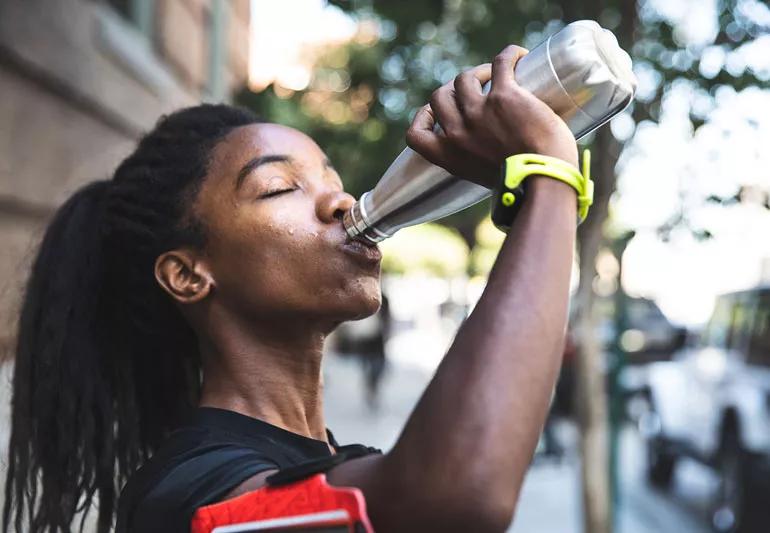Use these diet tips to keep your running regimen on track from start to finish

When you take part in any fitness activity, your body needs nutrients and fluids that are not only required for strength and endurance during the activity, but also help you recover from it.
Advertisement
Cleveland Clinic is a non-profit academic medical center. Advertising on our site helps support our mission. We do not endorse non-Cleveland Clinic products or services. Policy
This is especially true for runners. If you don’t have the proper nutritional and fluid balance headed into your run, you could risk draining your body of vital resources too quickly, or have less energy to complete your program. Dietitian Kate Patton, MEd, RD, CSSD, LD, offers advice on adopting a diet plan that fuels and hydrates you each time you step out the door.
“Whether you’re a new or casual jogger, a routine runner or training to run a marathon, you need a diet that’s high in carbohydrates, and moderate in protein and fat,” she says. “And as a rule, fluids are extremely important beyond simply quenching your thirst.”
About 50% to 70% of your diet should be carbohydrates.
“Resist the urge to jump on the low-carb bandwagon because you need them for energy if you’re a runner or someone who does regular cardio exercise,” Patton says. Carbs fuel the body with glycogen. This fuel is then stored in your muscles, which helps them perform. Not having enough carbs or cutting carbs out of your diet completely will make you feel fatigued and sluggish.
“If you run about one hour per day, you should aim to eat about five to seven grams of carbohydrates per kilogram of your body weight, For endurance runners who train one to three hours per day, six to ten grams of carbohydrate per kilogram body weight is needed” Patton recommends.
Advertisement
Here’s how to calculate how many carbs you need:
To ensure that you’ll have energy for running, make a list and stock up on these healthy sources of carbohydrates:
When you’re doing your pre-run shopping, read the labels for carbohydrate content and make sure you take portion size and your how long you’ll be running into consideration.
Protein helps build and repair muscle tissue. The right amount of protein promotes muscle growth, especially when you do strength training.
Here’s how to figure out how much protein you should eat to sustain for a one-to-two hour run:
“Protein intake at higher levels can also help you gain more muscle mass (and therefore strength) and can reduce the loss of muscle as you lose weight over time during your program,” Patton says.
Healthy sources of protein are easy to get quickly. To build and maintain your muscle strength for running, stock up on these high-protein foods:
With the right combination of protein and carbohydrates, your diet will be optimized for strength and endurance during your running routine.
When you exercise, your muscles generate heat. Your body needs to get rid of that heat to maintain a normal temperature — by sweating. Sweating in turn reduces your body’s water level, and this loss of fluid needs to be replenished during and after your activity. Patton emphasizes that you need to drink plenty of liquids to avoid dehydration and muscle cramping.
Your best options to add liquids to your diet before, during and after running are water and sports drinks (sports drinks replace electrolytes and potassium).
Advertisement
Before or after running, drink these:
“For the average hour-long run, drinking water while you’re running is a good guideline to stay hydrated,” Patton says. “But exactly how much you need depends on how much weight you lose during your run, and how long your actual run time is.”
Here are some guidelines on how to stay hydrated before, during and after your workout
“All of this takes practice out of the gate,” Patton says. “But in time you’ll have a strong sense of what your body needs and will begin to see how much more endurance you’ll have during your running program.”
Advertisement
Advertisement
Learn more about our editorial process.
Advertisement

Using precautions like bandages and lubricants can help you run away from this uncomfortable condition

Reducing your pace allows you to log more miles and train your body for the stress of running

Running doesn’t cause knee arthritis, but you can take steps to minimize cartilage damage

Months of preparation go into readying your body to run 26.2 miles

A few precautions can keep your toenails from turning black and falling off

Your body’s natural response to starting workouts may include an urge to scratch

What you should know before hitting a race before the big Thanksgiving meal

As a training tool, ditching your shoes could help you build better running form to avoid injury

Start having sex about 72 hours before ovulation, then at least every other day during your fertile window

Attachment theory suggests that your earliest relationships shape connections throughout your life

It isn’t a recognized mental health disorder, but research shows that problematic social media use can negatively affect your mental health, self-esteem and sleep